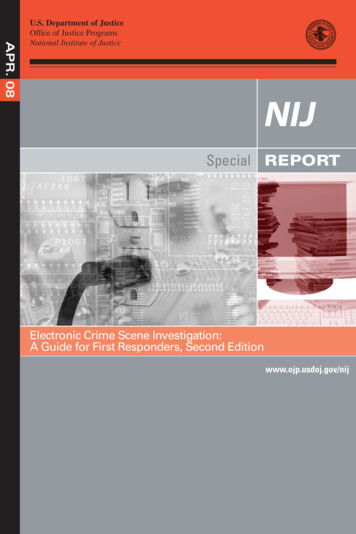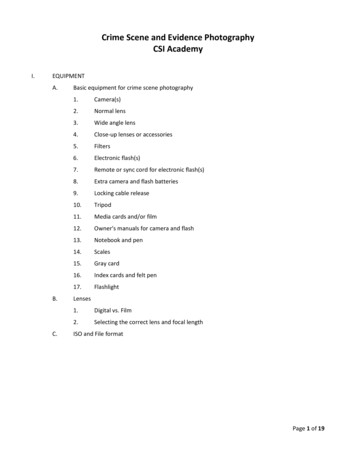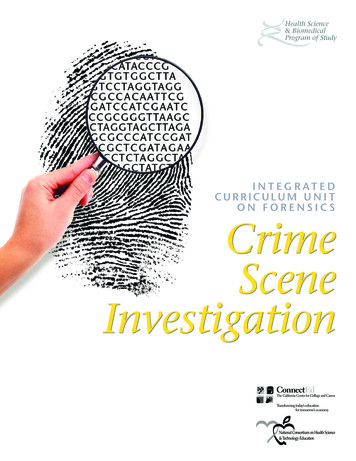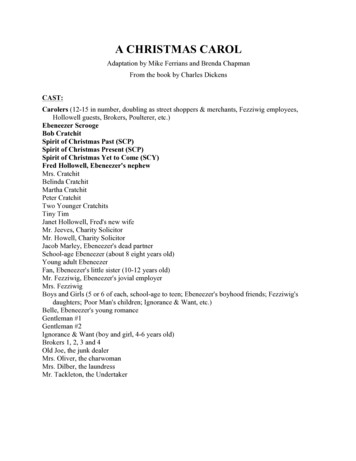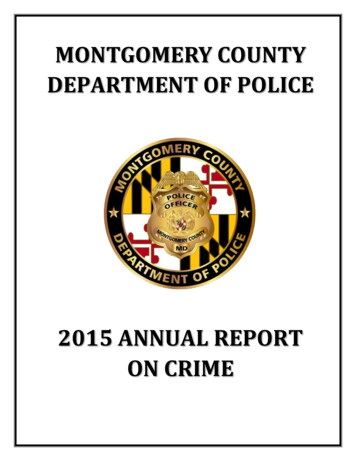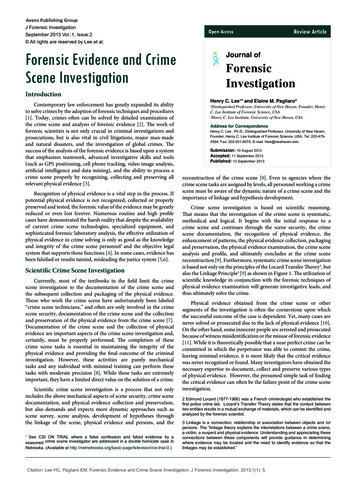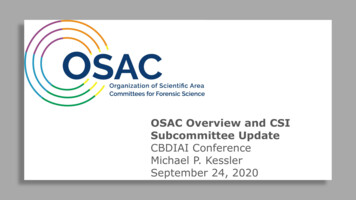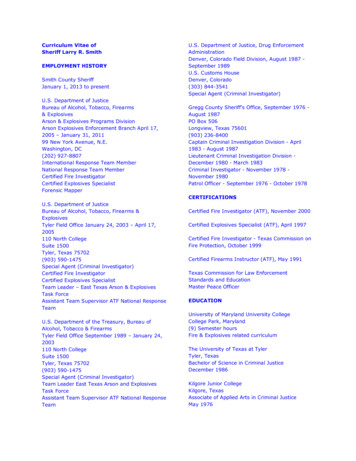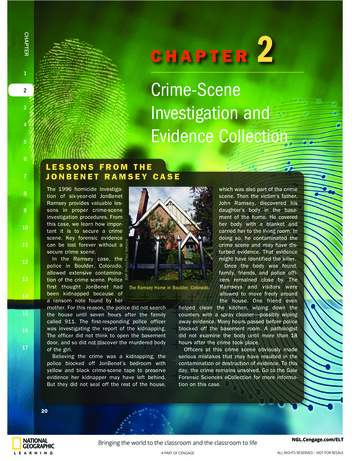
Transcription
CHAPTERCHAPTER1Crime-SceneInvestigation andEvidence Collection23457891011121314151617LESSONS FROM THEJONBENET RAMSEY CASEThe 1996 homicide investigawhich was also part of the crimetion of six-year-old JonBenetscene. Then the victim’s father,Ramsey provides valuable lesJohn Ramsey, discovered hissons in proper crime-scenedaughter’s body in the baseinvestigation procedures. Fromment of the home. He coveredthis case, we learn how imporher body with a blanket andtant it is to secure a crimecarried her to the living room. Inscene. Key forensic evidencedoing so, he contaminated thecan be lost forever without acrime scene and may have dissecure crime scene.turbed evidence. That evidenceIn the Ramsey case, themight have identified the killer.police in Boulder, Colorado,Once the body was found,allowed extensive contaminafamily, friends, and police offition of the crime scene. Policecers remained close by. Thefirst thought JonBenet had The Ramsey Home in Boulder, Colorado.Ramseys and visitors werebeen kidnapped because ofallowed to move freely arounda ransom note found by herthe house. One friend evenmother. For this reason, the police did not searchhelped clean the kitchen, wiping down thethe house until seven hours after the familycounters with a spray cleaner—possibly wipingcalled 911. The first-responding police officeraway evidence. Many hours passed before policewas investigating the report of the kidnapping.blocked off the basement room. A pathologistThe officer did not think to open the basementdid not examine the body until more than 18door, and so did not discover the murdered bodyhours after the crime took place.of the girl.Officers at this crime scene obviously madeBelieving the crime was a kidnapping, theserious mistakes that may have resulted in thepolice blocked off JonBenet’s bedroom withcontamination or destruction of evidence. To thisyellow and black crime-scene tape to preserveday, the crime remains unsolved. Go to the Galeevidence her kidnapper may have left behind.Forensic Sciences eCollection for more informaBut they did not seal off the rest of the house,tion on this case. AP Photo/Paul Sakuma622031559 02 ch02 p020-047.indd 2010/2/10 1:57:0
ObjectivesBy the end of this chapter you will be able to:2.1 Summarize Locard’s exchange principle.2.2 Identify four examples oftrace evidence.2.3 Distinguish between directand circumstantial evidence.2.4 Identify thetype of professionalswhoarepresent at a crime2.5 Summarizscene.e the seven steps of a crime-scen2.6 Explain theinvestigation.e importance ofsecuring the crim2.7 Identify thescene.e methods by which a crime scen2.8 Demonstrae is documented.te proper techniqueincollecttrace evidence.ing and packaging2.9 Describe how evidence froma crime scene isanalyzed.Vocabularychain of cudirect evidstody theence eviddocumenteunbrokenence thatrue) prodtransferandt (ifves an aofelvidenceleged fasuch ascircumstanct,an eyewitial evidentness acce (indirof a crievidencecountmeect) evidence usedimply afirst respontofact butder the fnot provdirectlyirst poliofficer toe itcearrive atsa crimeceneclass evidence material thaconnectsindividualtan indivevidenceidual orthing toa kind oevidencefa certaithat iden groupindividuantifiespar(seeticularl evidencaperson oe)r thingcrime-scenpaperbindle a fe investigaolded pation amultidisto holdper usedciplinartrace evy approawhich scidenccehprimary criinientificme sceneand legaprofessilthe locawhere thonals wotione crimerk togetto solvethoeok placera crimesecondarycrime scencrime-scene a locaother the reconstrtionan the puction ahypothesrimary cscene, bis of thrimeuet that isequenceevents fs in somrelatedofrom befoewaytro the cre the crwas commime, wheimeevidenceitted threris foundough itscommissiontrace evidence small butmeasurable amounts of phor bioloysicalgical material fat a crioundme scene31559 02 ch02 p020-047.indd 2110/2/10 1:57:46
CHAPTERI N T R OD U C T I ONHow is it possible to identify the person who committed a crime? A singlehair or clothing fiber can allow a crime to be reconstructed and lead policeto the responsible person. The goal of a crime-scene investigation is to recognize, document, and collect evidence at the scene of a crime. Solving thecrime will then depend on piecing together the evidence to form a pictureof what happened at the crime scene.123Obj. 2.1and 2.2P RI N C I P LE OF E XC H A NG E4Whenever two people come into contact with each other, a physical transferoccurs. Hair, skin cells, clothing fibers, pollen, glass fragments, debris froma person’s clothing, makeup, or any number of different types of materialcan be transferred from one person to another. To a forensic examiner,these transferred materials constitute what is called trace evidence. Somecommon examples of trace evidence include:567 Pet hair on your clothes or rugs Hair on your brush8 Fingerprints on a glass9 Soil tracked into your house on your shoes A drop of blood on a T-shirt10 A used facial tissue Paint chips11 Broken glass12 A fiber from clothingThe first person to note this condition was Dr. Edmond Locard, director of the world’s first forensic laboratory in Lyon, France. He establishedseveral important ideas that are still a part of forensic studies today. Locard’sexchange principle states that when a person comes into contact with an objector another person, a cross-transfer of physical evidence can occur. Theexchanged materials indicate that the two objects were in contact. Traceevidence can be found on both persons (and/or objects) because of thiscross-transfer. This evidence that is exchanged bears a silent witness to thecriminal act. Locard used transfer (trace) evidence from under a femalevictim’s fingernails to help identify her attacker.The second part of Locard’s principle states that the intensity, duration,and nature of the materials in contact determine the extent of the transfer.More transfer would be noted if two individuals engaged in a fistfight thanif a person simply brushed past another person.131415161722Crime-Scene Investigation and Evidence Collection31559 02 ch02 p020-047.indd 2210/2/10 1:58:1
Obj. 2.3TYP ES O F EV I D E NC EEvidence can be classified into two types: direct evidence and circumstantialevidence (Figure 2-1). Direct evidence includes firsthand observations suchas eyewitness accounts or police dashboard video cameras. For example, awitness states that she saw a defendant pointing a gun at a victim during arobbery. In court, direct evidence involves testimony by a witness about whatthat witness personally saw, heard, or did. Confessions are also considereddirect evidence.Circumstantial evidence is indirect evidence that can be used to imply afact but that does not directly prove it. No one, other than the suspect andvictim, actually sees when circumstantial evidence is left at the crime scene.But circumstantial evidence found at a crime scene may provide a linkbetween a crime scene and a suspect. For example, finding a suspect’s gunat the site of a shooting is circumstantial evidence of the suspect’s presencethere.Circumstantial evidence can be either physical or biological in nature.Physical evidence includes impressions such as fingerprints, footprints, shoeprints, tire impressions, and tool marks. Physical evidence also includesfibers, weapons, bullets, and shell casings. Biological evidence includesbody fluids, hair, plant parts, and natural fibers. Most physical evidence,with the exception of fingerprints, reduces the number of suspects to aspecific, smaller group of individuals. Biological evidence may make thegroup of suspects very small, or reduce it to a likely individual, which ismore persuasive in court.Trace evidence is a type of circumstantial evidence, examples of whichinclude hair found on a brush, fingerprints on a glass, blood drops on ashirt, soil tracked into a house from shoes, and others (Figure 2-2).Evidence can also be divided into class evidence and individual evidence.Class evidence narrows an identity to a group of persons or things. Knowingthe ABO blood type of a sample of blood from a crime scene tells us thatone of many persons with that blood type may have been there. It alsoallows us to exclude anyone with a different blood type. Individual evidencenarrows an identity to a single person or thing. Individual evidence typicallyhas such a unique combination of characteristics that it could only belongto one person or thing, such as a fingerprint.Figure 2-1. Classification oftypes of evidence.EvidenceDirect CircumstantialPhysicalBiologicalIt is relatively easy torecover DNA from cigarette ends found at thescene of a crime.Figure 2-2. Common examples of trace evidence.Animal or human hairFingerprintsSoil or plant material (pollen)Body fluids such as mucus, semen, saliva, or bloodFiber or debris from clothingPaint chips, broken glass, or chemicals such as drugs or explosivesCrime-Scene Investigation and Evidence Collection31559 02 ch02 p020-047.indd 232310/2/10 1:58:4
CHAPTERObj. 2.4Who is involved in a crime-scene investigation? The team is made upof legal and scientific professionals who work together to solve a crime.Professionals at the scene of a crime may include police officers, detectives,crime-scene investigators, district attorneys, medical examiners, and scientific specialists. Who is at the scene?123 Police officers are usually the first to arrive at a crime scene. A district attorney may be present to determine whether a search warrant is necessaryfor the crime-scene investigators.4 Crime-scene investigators document the crime scene in detail and collectphysical evidence. Crime-scene investigators include recorders to recordthe data, sketch artists to sketch the scene, photographers to take photosof the crime scene, and evidence collectors.56789T HE C R I ME - S C E NEI N V E S T I G A T I ON T E A MCrime-sceneinvestigation teams donot clean up the scene.This dirty job often fallsto the victim’s family.Professional crimescene cleaners can behired in many places todo this job.10Obj. 2.5,2.6,2.7,and 2.811 Medical examiners (also called coroners) may be necessary to determinethe cause of a death when a homicide has occurred. Detectives look for leads by interviewing witnesses and talking to thecrime-scene investigators about the evidence. Specialists such as entomologists (insect biologists), forensic scientists,and forensic psychologists may be consulted if the evidence requirestheir expertise.T HE S E V E N S ’ sO F C R I ME - S C E NE I NV E S T I G A T ION12SECURING THE SCENE13Securing the scene is the responsibility of the first-responding police officer(first responder). The safety of all individuals in the area is the first priority.Preservation of evidence is the second priority. This means the officer protects the area within which the crime has occurred, restricting all unauthorized persons from entering. Transfer, loss, or contamination of evidencecan occur if the area is left unsecured (Locard’s exchange principle). Thefirst officer on the scene will begin keeping a security log of all those whovisit the crime scene. The officer will collect pertinent information andrequest any additional needs required for the investigation. He or she mayask for more officers to secure the area. Depending on the nature of thecrime, the first-responding officer may request various teams of experts tobe sent to the crime scene.14151617SEPARATING THE WITNESSESSeparating the witnesses is the next priority. Witnesses must not be allowed totalk to each other. Their accounts of the events will be compared. This separation is done to avoid witnesses working together to create a story (collusion).The following questions need to be asked of each witness:24Crime-Scene Investigation and Evidence Collection31559 02 ch02 p020-047.indd 2410/2/10 1:58:6
When did the crime occur? Who called in the crime? Who is the victim? Can the perpetrator be identified? What did you see happen? Where were you when you observed the crime scene?SCANNING THE SCENEThe forensic examiners need to scan the scene to determine where photosshould be taken. A determination may be made of a primary crime scene andsecondary crime scene and priorities assigned regarding examination. A robbery in front of a store might be the primary scene, and the home of a suspectmight be the secondary scene. A murder may have taken place at one location (primary scene) and the corpse found at another (secondary scene).SEEING THE SCENEThe crime scene examiner needs to see the scene. Photos of the overallarea and close-up photos with and without a measuring ruler should betaken. Triangulation of stationary objects should be included in the photosas reference points. A view of the crime scene should be taken from severaldifferent angles and distances. Several close-up photos of any evidence andbodies should be taken.SKETCHING THE SCENEAn accurate rough sketch of the crime scene is made, noting the positionof the body (if any) and any other evidence. All objects should be measuredfrom two immovable landmarks. On the sketch, north should be labeledand a scale of distance should be provided. Any other objects in the vicinityof the crime scene should be included in the sketch. This includes doors,windows, and furniture.If the crime scene is out- Figure 2-3. A blank crime-scene sketch form showing the information that must bedoors, the position of provided with the sketch.trees, vehicles, hedges,and other structures orobjects should be includNed in the sketch. Later,a more accurate, finalcopy of the crime sceneshould be made for possible presentation in court.Scale: 1/4” feetComputer programs areavailable to later createa neater and more accuCase numberrate sketch suitable forDateuse in a court proceedLocationing. The sketch shouldNameinclude the informationindicated in Figure 2-3.Crime-Scene Investigation and Evidence Collection31559 02 ch02 p020-047.indd 252510/2/10 1:58:10
CHAPTERSEARCHINGFOR EVIDENCEWhat happened to Natalee Holloway in Aruba in 2005? This is anunsolved case in which questions have been raised about why crimescene investigators have not been able to find her body. In fact, investigators searched the island with an array of cutting-edge tools, from aremote-controlled submersible equipped with a video camera and sonarused for probing the water under bridges and in lagoons, to telescopingrods tipped with infrared sensors and cameras used for looking beneathmanhole covers and into shadowy caverns. Go to the Gale ForensicSciences eCollection on school.cengage.com/forensicscience andresearch the case. Make your own investigation by reading the primarysources available on the Web site. Write a brief explanation that summarizes the forensic tools used to find Holloway’s body and any evidence that was discovered during the search.Depending on the number of investigators, aspiral, grid, linear, orquadrant pattern shouldbe walked and locationof evidence marked,photographed,andsketched. Single investigators might use a grid,linear, or spiral pattern.A group of investigators might use a linear,zone, or quadrant pattern. These patterns aresystematic, ensuring that no area is left unsearched (Figure 2-4).Additional light sources might be needed to find hair and fibers. Avacuum cleaner with a clean bag is sometimes used to collect evidence butis not the method of choice. The use of a flashlight for examination andforceps for collecting are preferable, because this method avoids picking upextraneous materials.123456789Figure 2-4. Four crime-scene search t or ZoneSpiral14SECURING AND COLLECTING EVIDENCE15All evidence needs to be properly packaged, sealed, and labeled. Specificprocedures and techniques for evidence collection and storage must be followed. Liquids and arson remains are stored in airtight, unbreakable containers. Moist biological evidence is stored in breathable containers so theevidence can dry out, reducing the chance of mold contamination. After theevidence is allowed to air dry, it is packaged in a paper bindle. The bindle(or druggist’s fold) can then be placed in a plastic or paper container. Thisouter container is then sealed with tape and labeled with the signature ofthe collector written across the tape. An evidence log and a chain of custodydocument must be attached to the evidence container.The evidence log should contain all pertinent information, including: Case number Item inventory number161726Crime-Scene Investigation and Evidence Collection31559 02 ch02 p020-047.indd 2610/2/10 1:58:10
Description of the evidenceName of suspectName of victimDate and time of recoverySignature of person recovering the evidence Signature of any witnesses present during collectionPackaging EvidenceThe size of the bindle depends on the size of the evidence. If the evidence issmall, the bindle can be constructed from a sheet of paper. If the evidenceis large, the bindle might be constructed from a large sheet of wrappingpaper. The packaging techniques are demonstrated in Figure 2-5. The stepsare as follows:1.2.3.4.5.6.Choose the appropriate-size sheet of clean paper for the bindle.Crease the paper as shown in the figure.Place evidence in the X location.Fold left and right sides in.Fold in top and bottom.Insert the top flap into the bottom flap then tape closed. (Continued onpage 28.)Figure 2-5. Demonstration of packaging of dry evidence. Cengage Learninge. Secure bindle inlabeled evidence bagusing stick-on label.f. Place evidence in aplastic bag with an inserted evidence label. (Notethat this is a differentevidence source than thebloody cloth above.) Cengage Learningc. Place dried evidenceon bindle paper. Cengage Learningb. Allow evidence to dry. Cengage Learninga. Placement of evidence.d. Fold bindle. Tuck the topflap into the bottom. Cengage Learning Cengage Learning Cengage LearningXg. Seal and tape the edgeof the baggie.h. Write the collector’s signature across the baggie’staped edge.Crime-Scene Investigation and Evidence Collection31559 02 ch02 p020-047.indd 272710/2/10 1:58:14
CHAPTER7. Place bindle inside a plastic or paper evidence bag. Fold the bag closed.8. Place a seal over the folded edge of the evidence bag.9. Have the collector write his or her name over the folded edge.If a wet object to be packaged is large, it should be placed in a papercontainer and sealed to allow it to air dry. Wet evidence should never bepackaged in a plastic container while wet. Any DNA present will degenerateand evidence may become moldy and useless.There are standards for collecting different types of evidence thatdescribe how to collect and store the evidence. The Federal Bureau ofInvestigation and state police agencies publish descriptions of the properprocedures.Control samples must also be obtained from the victim for the purposeof exclusion. For example, blood samples found on a victim or at a crimescene are compared with the victim’s blood. If they match, the samples areexcluded from further study. If the blood samples do not match, then theymay have come from the perpetrator and will be further examined.123456CHAIN OF CUSTODY7In securing the evidence, maintaining the chain of custody is essential. Theindividual who finds evidence marks it for identification and bags the evidence in a plastic or paper container. The final container for the evidenceis a collection bag, which is labeled with the pertinent information. Thecontainer is then sealed, and the collector’s signature is written across thesealed edge.The container is given to the next person responsible for its care. Thatperson takes it to the lab and signs it over to a technician, who opens thepackage for examination at a location other than the sealed edge. On completion of the examination, the technician repackages the evidence with itsoriginal packaging, reseals the evidence in a new packaging, and signs thechain-of-custody log attached to the packaging. This process ensures thatthe evidence has been responsibly handled as it was passed from the crimescene to a courtroom (Figure 2-6).891011121314Figure 2-6. Chain-of-custody procedures.1516a. Original evidence bag28 Cengage Learning Cengage Learning Cengage Learning17b. Opened evidence bagmaintaining signature on first sealc. Original evidence bag withuncut seal and signature, updatedchain-of-custody log in a newsealed and signed evidence bagCrime-Scene Investigation and Evidence Collection31559 02 ch02 p020-047.indd 2810/2/10 1:58:23
O.J. Simpson is famous for having been tried and acquitted for themurder of his ex-wife Nicole Brown Simpson and her friend RonaldGoldman in 1994. The O.J. Simpson murder trial is often cited as aclassic example of how crucial evidence was lost, altered, or contaminated. Go to the Gale Forensic Sciences eCollection on school.cengage.com/forensicscience and research the case. Cite specificexamples of how evidence was damaged, lost, or contaminatedby crime-scene personnel. Write a brief explanation summarizingyour findings, making sure to back up your argument with sources.Carefully check the dates of the publications, and use applied logicto conclude whether you think the forensic evidence was improperlysecured.A N A L Y ZE T HE E V I D E NC EObj. 2.9 Dean Golja/Getty ImagesFollowing a crime-scene investigation, the forensic laboratory work begins(Figure 2-7). The FBI crime lab is one of the largest forensic labs in theworld. A forensic lab processes all of the evidence the crime-scene investigation collected to determine the facts of the case. Unlike what television CSIprograms portray, forensic lab technicians are specialized and process onetype of evidence.The laboratory results are sent to thelead detective. Test results eventually lead to Figure 2-7. A modern forensics laboratory.crime-scene reconstruction; that is, forminga hypothesis of the sequence of events frombefore the crime was committed through itscommission. The detective looks at the evidence and attempts to determine how it fitsinto the overall crime scenario. The evidenceis examined and compared with the witnesses’statements to determine the reliability of theiraccounts. Evidence analysis can link a suspectwith a scene or a victim, establish the identityof a victim or suspect, confirm verbal witnesstestimony, or even acquit the innocent. The evidence does not lie, but investigators must consider all possible interpretations of the evidence. Directevidence is more compelling than circumstantial evidence.C RI M E-S C EN E R E C ONS T R U C T I ONCrime-scene reconstruction involves forming a hypothesis of the sequenceof events from before the crime was committed through its commission.The evidence is examined and compared with the witnesses’ statements todetermine the reliability of their accounts.The investigator looks at the evidence and attempts to determine how it fits into the overall crime scenario.The evidence does not lie, but it could be staged. It is important that investigators maintain an open mind as they examine all possibilities.Crime-Scene Investigation and Evidence Collection31559 02 ch02 p020-047.indd 292910/2/10 1:58:28
CHAPTERS T A G E D C R I ME S C E NE S1Staged crime scenes pose a unique problem. The evidence does not matchthe testimony of witnesses. Here is a list of some common situations inwhich a crime scene is staged:2 Arson. The perpetrator stages a fire to cover some other crime such asmurder or burglary. Suicide/murder. A victim is murdered, and the perpetrator stages thescene to look like a suicide. The death may be caused by alcohol ordrug overdose. The motive could be insurance money, release from anunhappy marriage, or simply theft.345 Burglary. A burglary is staged to collect insurance money. In the determination of whether a crime scene is staged, the following points should beconsidered:6 Initially treat all death investigations as homicides. Do the type(s) of wounds found on the victim match the weapon employed?7 Could the wounds be easily self-inflicted? Establish a profile of the victim through interviews with friends and family.8 Evaluate the behavior (mood and actions) of the victim before the event. Evaluate the behavior (mood and actions) of any suspects before the event.9 Corroborate statements with evidential facts.10 Reconstruct the event. Conduct all forensic examinations to determine the facts of the case.11S U MMA R Y121314 Locard’s exchange principle states that contacts between people andobjects during a crime can involve a transfer of material that is evidenceof the crime.15 Evidence may be direct, as in eyewitness accounts, or circumstantial,which does not directly prove a fact.16 Evidence may be physical or biological. Trace evidence is a small amountof physical or biological evidence.17 A crime-scene investigation team consists of police officers, detectives,crime-scene investigators, medical examiners, and specialists. A crime-scene investigation consists of recognizing, documenting, andcollecting evidence from the crime scene. First-responding officers must identify the extent of a crime scene,including primary and secondary scenes, secure the scene(s), and segregate witnesses. After walking through the crime scene and identifying evidence, thecrime-scene investigators document the scene by taking photographsand preparing sketches of the scene.30Crime-Scene Investigation and Evidence Collection31559 02 ch02 p020-047.indd 3010/2/10 1:58:32
Evidence must be properly handled, collected, and labeled so that thechain of custody is maintained. Evidence is analyzed in a forensic laboratory, and the results are provided to detectives, who fit the results into the crime scenario.C A S E S T U DI ESLillian Oetting (1960)Three Chicago socialites were murdered in Starved Rock State Park, Illinois.All three women had fractured skulls. Their bodies, bound with twine, werefound in a cave. Near the bodies of the women, a bloodied tree limb wasfound and considered to be the murder weapon. Because all three womenhad been staying at a nearby lodge, the staff of the lodge was questioned.Chester Weger, a 21-year-old dishwasher at the lodge, was asked about ablood stain on his coat. He said it was animal blood. He agreed to take alie detector test and passed it. He was requestioned and took a second liedetector test and passed it as well. The blood was examined by the statecrime lab and found to be animal blood as Weger had indicated at questioning. The case reached a dead end.Investigators decided to revisit the evidence. The rope used to bind thewomen was examined more carefully. It was found to be 20-stranded twinesold only at Starved Rock State Park. Identical twine was found in an areaaccessible to Weger. He again became a prime suspect. The blood on hiscoat was reexamined by the FBI Crime Lab and found to be human and compatible with the blood of one of the victims. Weger submitted to another liedetector test and failed it. Weger was found guilty for the murder of one ofthe women, Lillian Oetting, and has spent more than 45 years in prison. Herecently petitioned the Governor of Illinois for clemency, saying he was beatenand tortured into making the confession. He still maintains his innocence.The Atlanta Child Murders (1979–1981)Wayne Williams is thought to be one of the worst serial killers of adolescentsin U.S. history. His victims were killed and thrown into the ChattahoocheeRiver in Georgia. Williams was questioned, because he was seen near wherea body had washed ashore. Two kinds of fiber were found on the victims.The first kind was an unusual yellow-green nylon fiber used in floor carpeting.Through the efforts of the FBI and DuPont Chemical Company, the carpetmanufacturer was identified. The carpet had been sold in only 10 states, oneof them being Alabama, where Williams lived. Thus, the fibers found on thevictims were linked to carpet fibers found in Williams’ home.Another victim’s body yielded the second type of fiber. This fiber was determined to be from carpeting found in pre-1973 Chevrolets. It was determinedthat only 680 vehicles registered in Alabama had a matching carpet. Williamsowned a 1970 Chevrolet station wagon with matching carpet. The probabilityof both types of fibers being owned by the same person was calculated. Theodds against another person owning both carpet types were about 29 millionto one. Williams was convicted and sentenced to two life terms.Think Critically Review the Case Studies and the information on investigatingcrime scenes in the chapter. Then explain how evidence obtained at a crime sceneis crucial to a successful case.Crime-Scene Investigation and Evidence Collection31559 02 ch02 p020-047.indd 313110/2/10 1:58:34
CHAPTER234567891011121314151617Crime-Scene InvestigatorThe crime-scene investido it again. I’m proud ofgator has a challengingthe work I’ve done.”job. His or her specialty isWhat is a typical dayin securing and processlike? Here is one sceing a crime scene. To benario: At the beginning ofwell versed in the field,a shift, you might be givenextensive study, training,a list of calls that haveand experience in crimecome in from police offiscene investigations arecers overnight. You willneeded. He or she must beneed to prioritize them andknowledgeable in theplan to investigate themareas of recognition, docuin a logical order. Oncementation, and preservayou arrive at the crimetion of evidence at a crimescene, you will work withscene to ensure that thosethe first-responding policerecovered items will arriveofficer and decide whatsafely at the lab. Investithe best methods are forgators generally turn in theyou to obtain evidence.evidence to forensic speYou will then record thecialistsforanalysis.scene using photographyHowever, they may have toand video, and gather evitestify in court about thedence such as shoe prints,evidence collected, theclothing fibers, blood, andmethods used to recov
did not examine the body until more than 18 hours after the crime took place. Officers at this crime scene obviously made serious mistakes that may have resulted in the contamination or destruction of evidence. To this day, the crime remains unsolved. Go to the Gale Forensic Sciences eCollec

